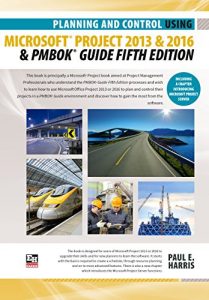This book is principally a Microsoft Project book aimed at Project Management Professionals who understand the PMBOK Guide Fifth Edition processes and wish to learn how to use Microsoft Office Project 2013 or 2016 to plan and control their projects in a PMBK® Guide environment and discover how to gain the most from the software.
The book is designed for users Microsoft Project 2013 or 2016 to upgrade their skills and for new planners to learn the software. It starts with the basics required to create a schedule, through resource planning and on to more advanced features. There is also a new chapter which introduces the Microsoft Project Server functions.
A Microsoft Project user guide and training manual written for Project Management Professionals following the PMBOK Guide Fifth Edition who wish to learn how to schedule projects in a single project environment with or without Resources with Microsoft Project. The book is packed with screen shots, constructive tips and is suitable as a training course handout, for learning the software or as a reference book. The book contains workshops with solutions at the end of each chapter for the reader to practice the skills taught in the chapter. Microsoft Project 2010 is an extensive software update with many new functions and as a result this is a complete rewrite of the author’s previous book.
Primarily a Microsoft Project book, it has been written for people learning to use Microsoft Project in a project environment applying the PMBOK® Guide Fifth Edition processes. It aims to teach readers how to plan and control projects created within the software package and stays focused on explaining how to use Microsoft Project to schedule projects by:
1.Explaining which PMBOK Guide processes the software will support and which it will not support.
2.Concentrating on the core functions required to plan a project.
3.Presents workable solutions to real day to day planning and scheduling problems and contains practical advice on how to set up the software.
4.Explains some of the important differences between Microsoft Project and other scheduling software.
5.Explains some of the more difficult calculations often omitted in other books.
6.Includes exercises to reinforce the learning outcomes, a large number of screen dumps, numerous tips, a detailed index and command list at the start of each chapter as a quick reference.
7.It has a new chapter introducing Microsoft Project Server.
About the Author:
Paul Harris holds an Honours Degree in Civil Engineering obtained in the UK and is a Certified Cost Engineer through AACEI International, a PRINCE2 Registered Practitioner, and a “Managing Successful Programmes” Registered Practitioner. He has worked in the project controls industry for a number of years and has assisted many companies in a range of industries to set up and run project controls systems. His Melbourne, Australia based company, Eastwood Harris Pty Ltd, offers project controls consulting and training services worldwide with a strong focus on Microsoft Project, Asta Powerproject and Primavera software.
The book is designed for users Microsoft Project 2013 or 2016 to upgrade their skills and for new planners to learn the software. It starts with the basics required to create a schedule, through resource planning and on to more advanced features. There is also a new chapter which introduces the Microsoft Project Server functions.
A Microsoft Project user guide and training manual written for Project Management Professionals following the PMBOK Guide Fifth Edition who wish to learn how to schedule projects in a single project environment with or without Resources with Microsoft Project. The book is packed with screen shots, constructive tips and is suitable as a training course handout, for learning the software or as a reference book. The book contains workshops with solutions at the end of each chapter for the reader to practice the skills taught in the chapter. Microsoft Project 2010 is an extensive software update with many new functions and as a result this is a complete rewrite of the author’s previous book.
Primarily a Microsoft Project book, it has been written for people learning to use Microsoft Project in a project environment applying the PMBOK® Guide Fifth Edition processes. It aims to teach readers how to plan and control projects created within the software package and stays focused on explaining how to use Microsoft Project to schedule projects by:
1.Explaining which PMBOK Guide processes the software will support and which it will not support.
2.Concentrating on the core functions required to plan a project.
3.Presents workable solutions to real day to day planning and scheduling problems and contains practical advice on how to set up the software.
4.Explains some of the important differences between Microsoft Project and other scheduling software.
5.Explains some of the more difficult calculations often omitted in other books.
6.Includes exercises to reinforce the learning outcomes, a large number of screen dumps, numerous tips, a detailed index and command list at the start of each chapter as a quick reference.
7.It has a new chapter introducing Microsoft Project Server.
About the Author:
Paul Harris holds an Honours Degree in Civil Engineering obtained in the UK and is a Certified Cost Engineer through AACEI International, a PRINCE2 Registered Practitioner, and a “Managing Successful Programmes” Registered Practitioner. He has worked in the project controls industry for a number of years and has assisted many companies in a range of industries to set up and run project controls systems. His Melbourne, Australia based company, Eastwood Harris Pty Ltd, offers project controls consulting and training services worldwide with a strong focus on Microsoft Project, Asta Powerproject and Primavera software.






